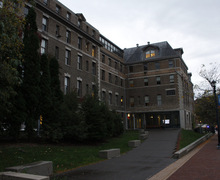Professor guides on-campus listening tour as part of Syracuse Symposium
Margaret Lin | Staff Photographer
Participants of the "Living in the Soundscape" tour perform a "Dome stomp." Other stops included Crouse College and the Abraham Lincoln statue.
The Carrier Dome is famous for a lot of things, but on Tuesday, the focus was put on sounds it emits: a flutter echo, more commonly known as a “Dome stomp.”
The Dome was one of the many stops on the “Living in the Soundscape” tour that encouraged participants to truly stop, unplug and absorb sounds from the world around them. The walking tour was part of the 2013 Syracuse Symposium on listening, and had a focus on the sonic elements of the Syracuse campus. Andrew Waggoner, a music composition professor and composer, led a tour of approximately 20 participants for the event.
“As a music professor, I’m in the business of listening and encouraging other people to listen,” Waggoner said. “To listen to music, one has to really listen to the world because music is a thing of the world.”
A big part of the tour focused on the contrast between listening to music through headphones and listening to the daily music and sounds from the hustle and bustle of real life.
Waggoner noted that music has historically been a social phenomenon that brought people from all walks of life together. But through his personal experience and background in music, he said headphones actually make society more isolated.
“What I’ve noticed is that students in particular — but also older types, like me — essentially stop listening at a certain point because the sonic environment is so saturated by music and different signals that are unwanted,” Waggoner said. “It’s gotten to the point where I think that most people in today’s world have disengaged from active, emotional and, dare I say, spiritual listening.”
The tour began in the Crouse College music practice hall, and Waggoner said he hoped that it would provide participants with a way of creating a playlist of natural sounds without any sort of digital medium.
While actively listening to the sounds throughout the building, the tour-goers heard a piano rendition of “Lean On Me,” a repetitive and consistent plinking of a singular piano key and the occasional ear piercing notes of an opera singer. Afterward, Waggoner delved into his observation that Crouse is one of the few places on campus where music becomes merely background noise because of how often it is played. He also said he was fascinated that members of administration sometimes ask professors to lower the music volume when they had events or meetings within the building.
“Sometimes they ask us to tune down music on audition days, which I find hilarious since we’re in a professional school of music,” Waggoner said. “I think those that come in here that aren’t engaging with this music is troubling.”
Waggoner then led the tour to the Abraham Lincoln statue between Maxwell Hall, Eggers Hall and Tolley Administration Building. He took note of the ambient traffic noises, the peacefulness of the wind and the overall prestigious atmosphere of the environment. He said it’s almost like people who cross through are restricted from doing anything too outlandish in an effort to preserve the spirit of Lincoln.
“Would you come to this sort of place and throw beer bottles at Abe? My response would be no,” Waggoner said.
Later stops during the tour included a secluded stairwell in Huntington Beard Crouse Hall, a bustling sidewalk on the Quad and the aforementioned famous spot by the Dome. In the stairwell, Waggoner commented on how rare silence was in today’s world; out on the Quad, he described how the leaves rustling in the wind was a delicate, scraping and deafening sound all at the same time.
Fifth-year architecture student Franklin Romero, who joined the tour to research for his thesis on global architecture in major cities and their relationships with city noise levels, gained an appreciation of paying close attention to even the most minute real-world noises through the tour.
“Always keep your ears open, because even the slightest white noise holds some interest,” Romero said. “There’s a sort of peace to all the white noise with the highway and trees and stuff like that. There’s definitely a lot to appreciate in terms of just getting to know Syracuse.”
Published on October 22, 2013 at 11:47 pm
Contact Margaret: mglin@syr.edu





